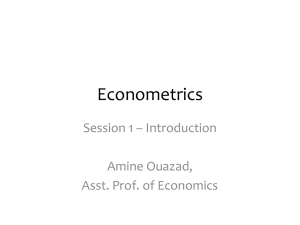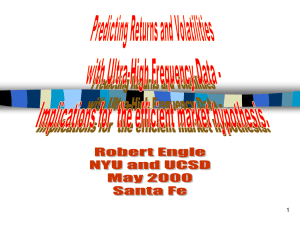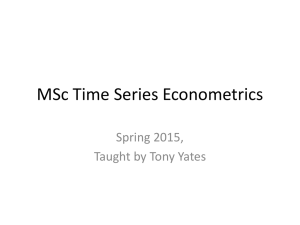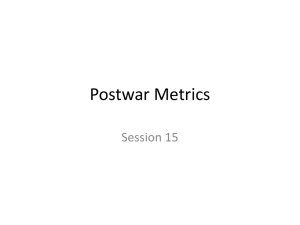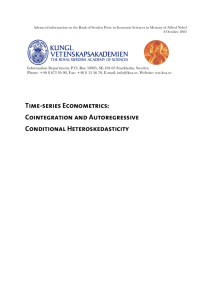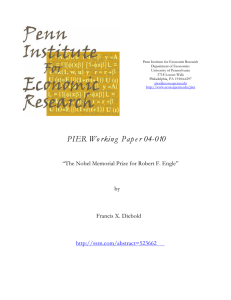Stephen W - East Carolina University
advertisement
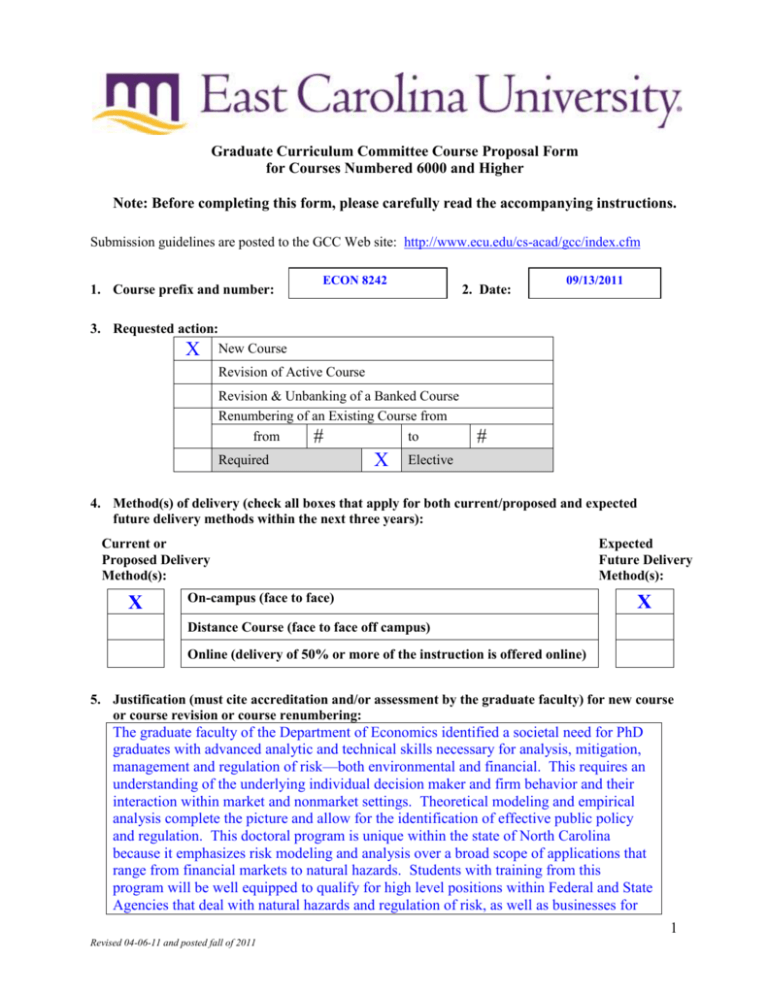
Graduate Curriculum Committee Course Proposal Form for Courses Numbered 6000 and Higher Note: Before completing this form, please carefully read the accompanying instructions. Submission guidelines are posted to the GCC Web site: http://www.ecu.edu/cs-acad/gcc/index.cfm 1. Course prefix and number: ECON 8242 2. Date: 09/13/2011 3. Requested action: X New Course Revision of Active Course Revision & Unbanking of a Banked Course Renumbering of an Existing Course from from to # Required X # Elective 4. Method(s) of delivery (check all boxes that apply for both current/proposed and expected future delivery methods within the next three years): Current or Proposed Delivery Method(s): X On-campus (face to face) Expected Future Delivery Method(s): X Distance Course (face to face off campus) Online (delivery of 50% or more of the instruction is offered online) 5. Justification (must cite accreditation and/or assessment by the graduate faculty) for new course or course revision or course renumbering: The graduate faculty of the Department of Economics identified a societal need for PhD graduates with advanced analytic and technical skills necessary for analysis, mitigation, management and regulation of risk—both environmental and financial. This requires an understanding of the underlying individual decision maker and firm behavior and their interaction within market and nonmarket settings. Theoretical modeling and empirical analysis complete the picture and allow for the identification of effective public policy and regulation. This doctoral program is unique within the state of North Carolina because it emphasizes risk modeling and analysis over a broad scope of applications that range from financial markets to natural hazards. Students with training from this program will be well equipped to qualify for high level positions within Federal and State Agencies that deal with natural hazards and regulation of risk, as well as businesses for 1 Revised 04-06-11 and posted fall of 2011 management and mitigation of risk. The assessment process of the Economics Graduate Faculty has determined that this course should be the second in a two-course PhD field sequence in applied macroeconomics. 6. Course description exactly as it should appear in the next catalog: 8242. Applied Macro II (3) P: ECON 8241. Development of the econometric tools necessary for advanced research in financial risk analysis. 7. If this is a course revision, briefly describe the requested change: N/A 8. Course credit: Lecture Hours 3 3 Weekly OR Per Term Credit Hours s.h. Lab Weekly OR Per Term Credit Hours s.h. Studio Weekly OR Per Term Credit Hours s.h. Practicum Weekly OR Per Term Credit Hours s.h. Internship Weekly OR Per Term Credit Hours s.h. Other (e.g., independent study) Please explain. s.h. 3 Total Credit Hours s.h. 6 9. Anticipated annual student enrollment: 10. Changes in degree hours of your programs: Degree(s)/Program(s) Changes in Degree Hours PhD/ Economics N/A 11. Affected degrees or academic programs, other than your programs: Degree(s)/Program(s) Changes in Degree Hours 12. Overlapping or duplication with affected units or programs: X Not applicable Documentation of notification to the affected academic degree programs is attached. 13. Council for Teacher Education (CTE) approval (for courses affecting teacher education): X Not applicable Applicable and CTE has given their approval. 2 Revised 04-06-11 and posted fall of 2011 14. University Service-Learning Committee (USLC) approval: X Not applicable Applicable and USLC has given their approval. 15. Statements of support: a. Staff Current staff is adequate X Additional staff is needed (describe needs in the box below): b. Facilities X Current facilities are adequate Additional facilities are needed (describe needs in the box below): c. Library X Initial library resources are adequate Initial resources are needed (in the box below, give a brief explanation and an estimate for the cost of acquisition of required initial resources): d. Unit computer resources X Unit computer resources are adequate Additional unit computer resources are needed (in the box below, give a brief explanation and an estimate for the cost of acquisition): e. ITCS resources X ITCS resources are not needed The following ITCS resources are needed (put a check beside each need): Mainframe computer system Statistical services Network connections Computer lab for students Software MATLAB Approval from the Director of ITCS attached 16. Course information (see: Graduate Curriculum and Program Development Manual for instructions): a. Textbook(s) and/or readings: author(s), name, publication date, publisher, and city/state/country. Include ISBN (when applicable). Textbooks: Gourieroux, C. & J. Jasiak. (2001). Financial Econometrics. Princeton, NJ: Princeton University Press. 3 Revised 04-06-11 and posted fall of 2011 Tsay, R. S. (2002). Analysis of Financial Time Series. Hoboken, NJ: Wiley Series in Probability and Statistics. O'Hara, M. (1995). Market Microstructure Theory. Cambridge, MA: Blackwell Publishers. Campbell, Lo, & MacKinlay. (1997). The Econometrics of Financial Markets. Princeton, NJ: Princeton University Press. . Hamilton, J. (1994). Time Series Analysis. Princeton, NJ: Princeton University Press. Readings: Amin & Ng. (1993). Option Valuation with Systematic Stochastic Volatility. Journal of Finance (48, pp. 881-910). Bollerslev, Engle & Nelson. (1994). ARCH Models. Handbook of Econometrics (49). 4, North Holland. Burns, P. E. & Mezrich. (1998). Volatilities and Correlations for Asynchronous Data. Journal of Derivatives. Capiello, E. & Sheppard. (2002). Asymmetric Dynamic Correlations of Global Equity and Bond Returns. European Central Bank Discussion Paper. Diebold, F., & Mariano, (1995). Comparing Predictive Accuracy. Journal of Business and Economic Statistics (13, pp. 253-263). Duan, J.C. (1995). The GARCH Option Pricing Model. Mathematical Finance (5, pp. 13-32). Dufour & Engle. (2000). Time and the Price Impact of a Trade. Journal of Finance ( 55, pp. 2467-2498) Engle. (2001). GARCH101: The Use of ARCH/GARCH Models in Applied Econometrics. Journal of Economic Perspectives (15, pp.157-168). Engle. (2000). The Econometrics of Ultra-High Frequency Data. Econometrica. Engle. (2001). Financial Econometrics - A New Discipline With New Methods. Journal of Econometrics (100, pp.53-56). Engle. (2002). Dynamic Conditional Correlation: A Simple Class of Multivariate GARCH Models. Journal of Business and Economic Statistics (20, pp. 339-350). 4 Revised 04-06-11 and posted fall of 2011 Engle, R.F. & Mezrich, J. (1995). Grappling with GARCH. Risk. September Engle, R.F. & Mezrich, J. (1996). GARCH for Groups. Risk (9, pp. 36-40). Engle & Rosenberg. (1995). GARCH Gamma. Journal of Derivatives (2, pp. 47-59). Engle, R.F. & Russell J. (1998). Autoregressive Conditional Duration: A New Model for Irregularly Spaced Transaction Data. Econometrica. Engle & Kroner. (1995). Multivariate Simultaneous Generalized ARCH. Econometric Theory (11, pp.122-150). Engle & Lange. (2001). Measuring, Forecasting and Explaining Time Varying Liquidity in the Stock Market. Journal of Financial Markets (4, pp. 113-142). Engle & Susmel. (1993). Common Volatility in International Equity Markets. Journal of Business and Economic Statistics (11, pp.167 – 176). Lo, A.W. & C.A. MacKinlay. (1990). An Econometric Analysis of Nonsynchronous Trading. Journal of Econometrics (45, pp.181-211). Rosenberg & Engle. (1998). Empirical Pricing Kernels. Journal of Financial Economics. (64). Sullivan, R., Timmermann A., & White H. (1999). Data Snooping, Technical Trading Rule Performance, and the Bootstrap. Journal of Finance (pp.1647-1692). White, H. (1999). Bootstrap Snooper Reality Check. Econometrica. b. Course objectives for the course (student – centered, behavioral focus) Upon completion of this course, students will be able to: Use financial data in their PhD research with the tools they need for state-of-the-art empirical research; apply the econometric theory of financial time series analysis, with an emphasis on recent developments; analyze selected recent works in financial modeling with an emphasis on their empirical implications and analysis. c. Course topic outline I. Forecasting Returns II. Forecasting Volatility III. Pricing and Hedging Options IV. Extreme Values and Value-at-Risk V. Asset Allocation VI. Market Microstructure 5 Revised 04-06-11 and posted fall of 2011 d. List of course assignments, weighting of each assignment, and grading/evaluation system for determining a grade 5 Problem sets: Midterm Exam: Course Paper: Final Exam: 25% 25% 25% 25% Evaluation system is A for outstanding performance, B for acceptable performance, C for inadequate performance, and F for failure. 6 Revised 04-06-11 and posted fall of 2011




